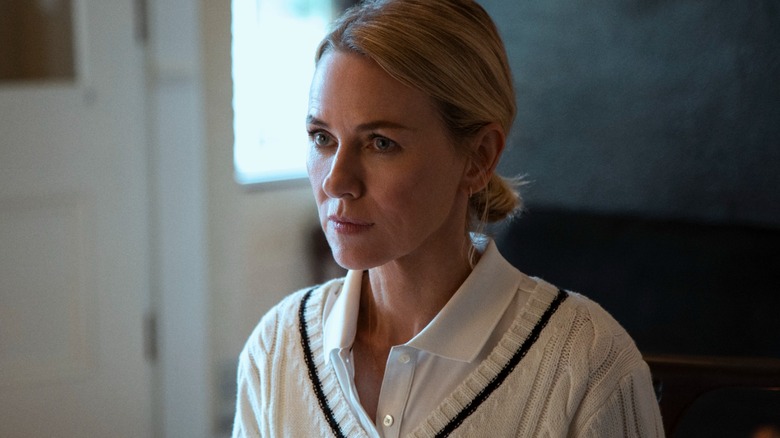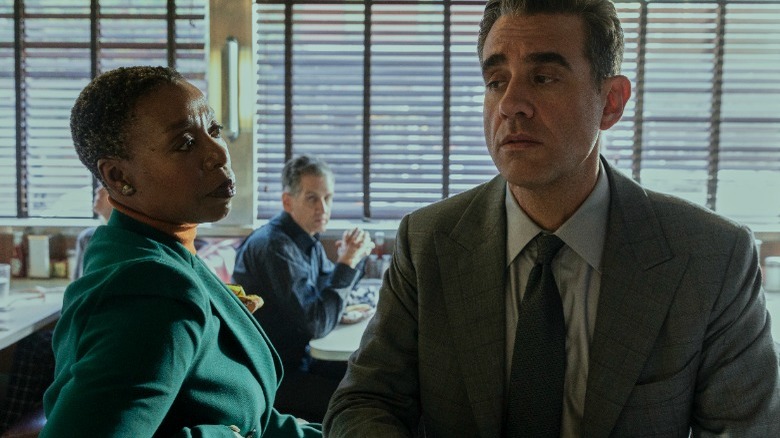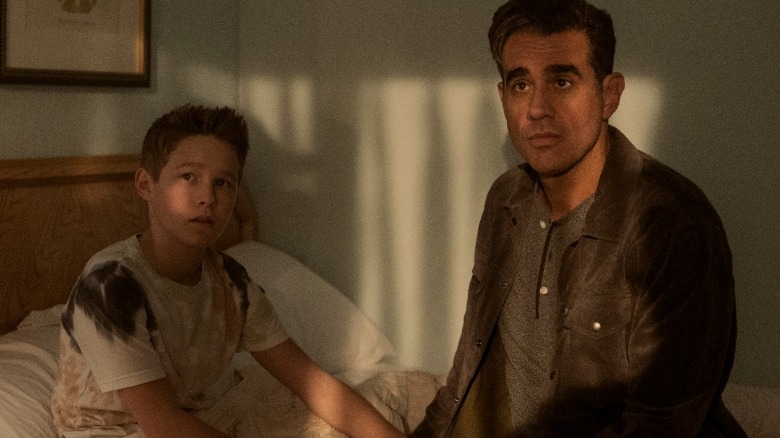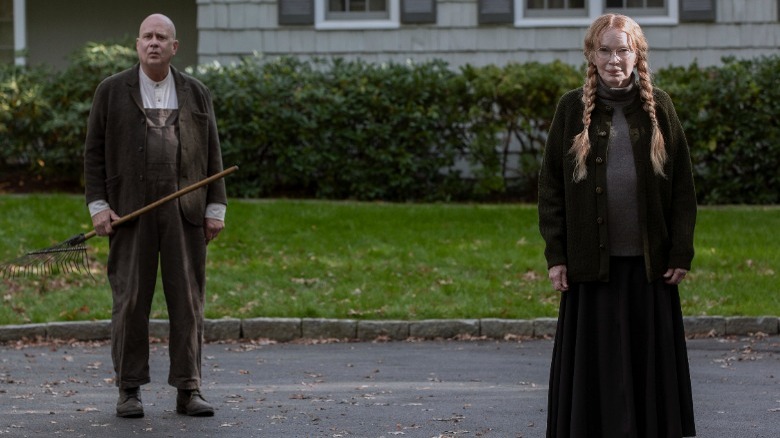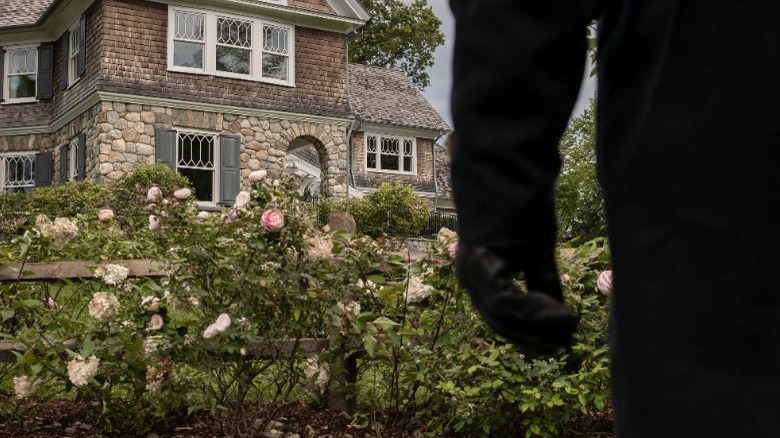The Watcher Ending Explained: A Culture Of Paranoia, Revealed
Netflix's "The Watcher" is the kind of show that makes you want to talk to your TV screen. The endlessly twisty, perpetually borderline nonsensical series that's loosely based on a true story necessitates more than the occasional "WHAT?!" response. It's a show that keeps viewers guessing right up until the moment it ends, and indeed, at some points seems designed more as a guessing game than an actual narrative.
The series is about the Brannock family: Bobby Cannavale's high-anxiety patriarch Dean, Naomi Watts as his artist wife Nora, and their two teen kids. But more aptly, it's about one family's experience with fear and paranoia in the form of anonymous threatening letters, and the way those feelings seem to spread like a virus to the people around them. Was "The Watcher" successful at everything it tried to do? Not quite. But was it entertaining to watch the show throw everything at the wall and see what sticks? Definitely. It was also, to be frank, pretty baffling.
Let's parse through some of the finer points of the series' biggest mysteries.
So, who was The Watcher?
The short answer is: we don't know! Across its seven episodes, the series presents one or more suspects per episode, feeding the Brannocks and us viewers increasingly convincing theories every time. Then it leaves us hanging, with a scene that shows real estate agent and new 657 Boulevard owner Karen (Jennifer Coolidge) scared out of her wits after someone kills her dog. We also see a hooded figure in Karen's home, revealing that the threat of The Watcher was real the whole time.
Plus, there's the Dean of it all. The man who's been most bothered by The Watcher this whole time ends the series becoming a watcher himself, using the fake name John — the same name as the maybe-fake man who maybe killed his family in the house before — as he observes the home's new owners. He lies to Nora about it, but it turns out she's parked nearby too, watching him watch the house. Does all of this mean Dean was The Watcher all along? Were some of the more damning evidence scenes we saw the product of his own mind? Maybe, but I also think it's not so simple as all of that.
The power of fear and paranoia
At its core, "The Watcher" seems to be about conspiratorial thinking and the way it can diminish a person's capacity for reason. Throughout the series, sinister-seeming characters co-opt fearmongering language when they talk about how the world is no longer safe, and reminisce about how people used to leave their doors unlocked. Interestingly, the series also often presents us with purposely bad evidence, like the handwriting analysis (this is a deeply unreliable pseudoscience), stories "you won't read in the news," and Dean's assertion that the city is dangerous despite the fact that nothing bad ever happens to the Brannocks there.
"The Watcher" seems to care less about who its titular stalker is, and more about making a broader point about how easy it is to buy into a culture of fear and paranoia. Seth Gabel's character, the QAnon believer Andrew, is a perfect example of this. He tells a bonkers story about neighbors sucking the blood of children for its adrenochrome (a real-life conspiracy theory with antisemitic roots). Dean, whose fear is heightened and guard is down, is as eager to believe this wild tall tale as he is to buy into much more reasonable stories.
That's because, as "The Watcher" tells it, fear sells big time. Another undercurrent running through the series is the idea that no matter how much money you dump into home security systems, private investigators, or various technologies meant to ensure you can sleep soundly, you'll never be able to buy a sense of security. The end of "The Watcher" doesn't seem to be so much as an admission of Dean's guilt, but an admission that he'll never be able to escape his fixation on the house — and the idyllic, safe, unattainable American dream it represented to him.
A rundown of suspects
While "The Watcher" leaves viewers to decide which story they believe, some theories about the shadowy stalker seem more viable than others. There are four that I think hold water: Karen and Detective Chamberland (Christopher McDonald), the members of the Westfield Preservation Society, John Graff, and Dean himself.
Dean is an obvious choice, but perhaps the least likely culprit of the group. Sure, he goes by John at the end of the finale and watches the new owners get their mail, but this could as easily be a sign of his mental decline as anything else. Plus, it's undeniable that something has been going on with the house, as a dozen or so people all have some sort of anxiety-ridden connection to it. Dean is also clearly deeply traumatized by The Watcher letters, to the point that if he did write them himself, it seems like something he wouldn't do consciously. There's no real evidence pointing to him having a dissociative disorder besides the offhand use of the name John, which isn't very substantial.
There's also the possibility that Bill, the mysterious member of the Preservation Society, really is the long-hidden killer John Graff. This is a sort of classic Ryan Murphy option, as it would leave several plot holes. For example, was he living in the tunnels this whole time? How did he become besties with Pearl? The Graff story always read to me like unsubstantiated fodder for conspiracy-minded Dean, the sort of sensationalized urban legend that can dig its hooks into a person but, in reality, may not have happened. Plus, like the throwaway line where Dean calls himself John, there's only one teasing indicator that Bill could be John Graff: when Roger Kaplan (Michael Nouri) pointedly asks him how his family's doing.
Some likely culprits
This brings us to the most realistic culprits. As mentioned, "The Watcher" is pretty obsessed with money, status, and the idea of the American dream being under attack — even if by forces that aren't really there. The Westfield Preservation Society, which is composed of Pearl Winslow, her brother Jasper (Terry Kinney), Bill, Roger, and Mo (Margo Martindale), clearly feels threatened by the presence of new people and the change they bring to 657 Boulevard.
They obsess over countertops, trees, and dumbwaiters, and feel dramatically hurt whenever new owners try to apply their personal tastes to the property. In the finale, shortly before Karen begins getting terrorized, they hint that they've used nefarious means to bother the residents before. Pearl says they're "not officially" allowed to weigh in on new owners' decision-making, "but we do make very strong recommendations." Could those recommendations be achieved courtesy of those secret passageways between the Winslow home and 657 Boulevard?
In the end, the secret passageways seem the closest we'll ever get to a smoking gun, but there's one more theory that could check out. We know the LLC scheme orchestrated by Karen and Detective Chamberland is real, and it seems like Karen purposely spreads a story about a grisly murder around in order to create a vacuum in the market that she can fill as a real estate agent. The theory Dean and Nora present to the couple at the country club makes total sense, and unlike many other suspects, they never actually explain it away. In that case, who killed Karen's dog? Well, by that point she and Detective Chamberland seem to have gone through a nasty breakup, and he refuses to help her when she's in a panic, so it's possible he hired someone to continue The Watcher ruse.
What about in real life?
While Murphy and Ian Brennan's version of "The Watcher" is headache-inducingly complex, the true story was slightly simpler. The best retelling of events — which is also the version this series was very loosely based on — comes courtesy of a feature Reeves Wiedman wrote for The Cut in 2018. It's true that a family who tried to move into a Westfield, New Jersey home in 2014 was met with a series of super-creepy letters, which were read verbatim in the new series. But it's safe to say a good amount of the Netflix series is the stuff of invention.
In reality, the Broaddus family — husband Derek, wife Maria, and three kids — never fully moved into the home, as the letters began coming just days after they closed a deal on the house. Instead, once the letters arrived, they moved in with Maria's parents, although by all accounts it does sound like Derek Broaddus did spend a lot of money on security cameras and private investigators to try to get to the bottom of the mystery.
Though the real-life Watcher was never identified, the longform article by Wiedman also runs through a list of suspects, including an odd neighboring family called the Langfords, a young man whose video game handle may have been The Watcher, a pair of neighbors with lawn chairs facing the house, and more. And while there was no murder at 657 Boulevard, the article gives the same sense as the series does, that almost anyone could be responsible for the letters. "The range of proposed suspects," Wiedman writes, "included a jilted mistress, a spurned Realtor, a local high-schooler's creative-writing project, guerrilla marketing for a horror movie, and 'mall goths having fun.'" In real life, as in the series, it's a mystery left unsolved.
